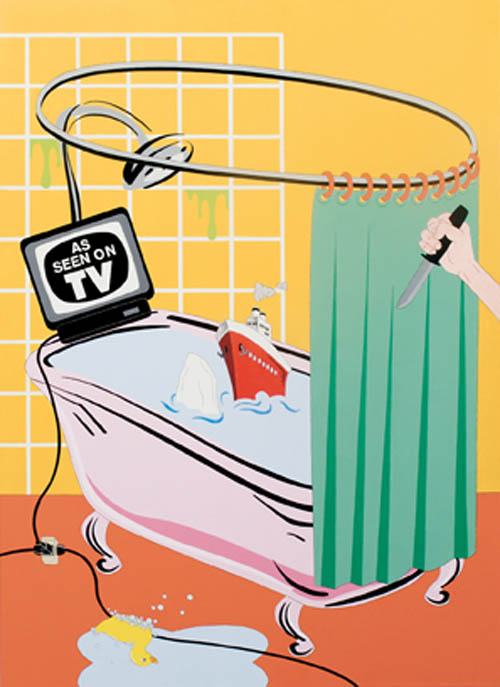Nancy Chunn: Chicken Little and the Culture of Fear
Museum of Art, Rhode Island School of Design • Providence, RI • risdmuseum.org • Through April 15, 2012

What to do now that satire is dead? The realities of society’s political and economic life are apparently so grotesque in themselves as to preclude any possibility of exaggeration. Nancy Chunn’s solution to this problem is a trick of fable. Out of a story rendered harmless by its overfamiliarity, she assembles comic catalogues of debris into altarpieces from a profane world.
Chunn has obviously made a commitment to documenting the rise and fall of our local empire entirely in domestic terms. In the bathroom are the cartoon disasters of overloaded electrical sockets, shelves of toxins, an infrastructure of roaches, fire dancing out of the wastebasket, and razorblades scattered on the floor—all waiting to fracture our pitiable daily routines. Alongside the bathtub with its miniature sinking Titanic and an outstretched hand clutching a knife, straight out of Hitchcock’s Psycho, is the immeasurable terror of an empty toilet paper roll. Then there is the fantasy of a boudoir with the skull placed on a vanity, making literal the mortality paintings of the Renaissance vanitas, as well as Hamlet’s instruction to what is left of Yorick the jester,
“Now get you to my lady’s chamber, and tell her, let her paint an inch thick, to this favour she must come…”
And sure enough, Death is sitting nearby, next to the ubiquitous television whose fall from above to thwack the gullible fowl of the work’s title has set off the whole cascade of events that Chunn is narrating. Meanwhile, another class of secret skeletons crowd out of the closet door in homage to an early Walt Disney cartoon of dancing bones. The artist draws from a Walmart of imagery for her storytelling, some of the pictures are both out of reach and sight, as they are when we leave the gallery to be surrounded by the cacophony of the Providence street. Our only certainty is in the repeated mantra of “as seen on TV” in an archaic black-and-white
version of reality. One exemplary panel in the Chunn exhibition is able to stand for all. With its cartoon duck under a street lamp, a small hand is just visible above the surface of a pond, “not waving but drowning.” Does Chunn have to tell us any more? Could anyone insist more potently about our strange human comedy than this?
—Stephen Vincent Kobasa
